
The topological properties of a material depend on its symmetries, parameters, and spatial dimension. Changes in these properties due to parameter and symmetry variations can be understood by computing the corresponding topological invariant. Since topological invariants are typically defined for a fixed spatial dimension, there is no existing framework to understand the effects of changing spatial dimensions via invariants.
In this work recently published in Communications Physics, a CINT User Team including Alexander Cerjan introduced a framework to study topological phase transitions as a system’s dimensionality is altered using real-space topological markers. CINT highlight slide here.
Full article here: Dimensional Crossover of Class D Real-Space Topological Invariants
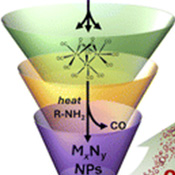
Low-temperature, scalable routes to transition metal nitride (TMN) nanoparticles are desirable for a wide range of applications, yet their synthesis typically requires high temperatures (>350 °C) and reactive gas environments (e.g., NH3 or H2/N2)
In this work, a CINT User Team including Sergei Ivanov and John Watt report a colloidal synthesis of mono- and bimetallic TMN nanoparticles using preformed metal carbonyl clusters as precursors and urea or diethylenetriamine (DETA) as nitrogen sources. This strategy enables access to size-controlled, phase-pure ε-Fe3Nx and FeyNi3−yN nanoparticles at temperatures below 300 °C, without the need for flowing reactive gas atmospheres. CINT highlight slide here.
Full article here: Low-Temperature Access to Active Iron and Iron/Nickel Nitrides as Potential Electrocatalysts for the Oxygen Evolution Reaction
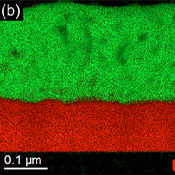
Resistive switching (RS) devices with ultra-low-voltage threshold and reliable switching repeatability exhibits great potential applications in energy-efficient data storage and neuromorphic computing. Understanding switching mechanisms at nanoscale is critical to design RS devices with improved performance.
In this work published in Advanced Functional Materials, a CINT User Team including Di Zhang, Sundar Kunwar, Michael Pettes, John Watt, Winson Kuo, and Aiping Chen fabricated a lamella memristive device using the focused ion beam (FIB) method based on a metal/TiOx/TiN/Si structure. CINT highlight slide here.
Full article here: In Situ Study of Resistive Switching in a Nitride-Based Memristive Devic
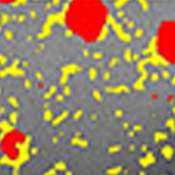
Sodium solid-state batteries (Na-SSBs) are an emerging alternative to lithium-ion batteries that have dominated the energy storage market for the last three decades. Compared to lithium, sodium is abundant and evenly distributed in the Earth's crust, making it an attractive candidate for energy storage solutions, such as sodium-ion and sodium-metal batteries. However, unlike lithium, sodium cannot intercalate effectively into graphite, necessitating the development of alternative anodes.
In this study published in Advanced Materials, a CINT User Team including John Watt presented the first reported use of reactive carbide precursors, ZrC and SiC, for the solid-state synthesis of NZSP. This novel approach leverages an exothermic reaction pathway that facilitates improved densification, phase purity, and microstructural distribution. CINT highlight slide here.
Full article here: Reactive Carbide-Based Synthesis and Microstructure of NASICON Sodium Metal All Solid-State Electrolyte
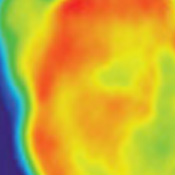
Solid-state lithium batteries promise higher energy density and improved safety compared with conventional liquid-electrolyte batteries, but their performance is often limited by lithium dendrite growth — tiny metallic filaments that penetrate and short-circuit the electrolyte.
In this study a CINT User Team introduced a new grain boundary–engineered garnet electrolyte, where zirconia (ZrO₂) nanoparticles form in situ during sintering at the interfaces between grains of the standard Li₆.₄La₃Zr₁.₄Ta₀.₆O₁₂ (LLZTO) material. The process uses a reactive tantalum carbide (TaC) additive that decomposes to release oxygen and substitute tantalum for zirconium in the crystal lattice, creating a two-phase oxide–oxide composite with controlled microstructure and chemistry. CINT highlight slide here.
Full article here: Grain Boundary Zirconia-Modified Garnet Solid-State Electrolyte
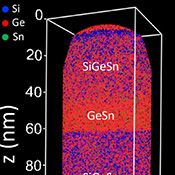
GeSn is an emerging material with potential applications in nex-generation integrated optoelectronics and quantum information processing. While GeSn/SiGeSn quantum wells exhibit promising optical properties, their electrical transport characteristics and governing electrostatics in gated structures remain unexplored.
In this work, a CINT User Team fabricated heterostructure field-effect transistors with two different well/barrier compositions. Remarkably, devices with SiGeSn barriers exhibited mobilities several times higher than previously reported GeSn quantum wells with conventional germanium barriers at low carrier densities. These results contradict the initial expectation that the ternary alloy would introduce more scattering. Using atom probe tomography at Dartmouth, the team identified short-range ordering of silicon atoms in the SiGeSn barrier layers, which may template improved ordering in the GeSn quantum well during growth and reduce alloy scattering effects. CINT highlight slide here.
Full article here: High Mobility and Electrostatics in GeSn Quantum Wells With SiGeSn Barriers
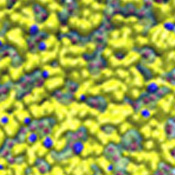
Ion exchange membranes have been the focus of continued research for applications such as electrolysis, electrodialysis, energy conversion, and energy storage. Ion exchange membranes are broadly classified by the charge of the mobile counterion, being either a cation exchange membrane (or, when specifically referring to protons, a proton exchange membrane, or PEM) or an anion exchange membrane (AEM). Particularly for applications in fuel cells, AEMs are a research focus because they avoid the need for expensive catalysts such as platinum typically used in PEM-based fuel cells. A multitude of synthetic routes for AEMs are found in the literature, resulting in polymers with various cationic functional groups.
In this work, a CINT User Team including Amalie Frischknecht investigated the morphology and transport properties of a new class of polymers using atomistic molecular dynamics simulations, which are functionalized with quaternary ammonium groups for use as anion exchange membranes. CINT highlight slide here.
Full article here: Investigating Morphology and Diffusion in Simulations of Precise Anion-Conducting Polymers
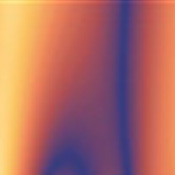
Flat bands in twisted materials have attracted considerable attention due to the emergence of correlated phases that can be associated with the non-Wannier-representable nature of its single-particle states. Specifically, these bands can exhibit a class of topology that can be nullified by the addition of trivial bands, termed fragile topology, which has required an expansion of prior classification schemes. However, existing approaches for predicting fragile topology rely on momentum-space methods, e.g., Wilson loops, presenting a fundamental challenge for using fragile topology as a predictor of correlated phases in aperiodic systems, such as incommensurate twist angles in moiré materials.
In this work, a CINT-led User Team including Ki Young Lee, Stephan Yong, and Alexander Cerjan developed a ℤ2 energy-resolved topological marker for classifying fragile phases using a system’s position-space description, enabling the direct classification of finite, disordered, and aperiodic materials. CINT highlight slide here.
Full article here: Classification of Fragile Topology Enabled by Matrix Homotopy
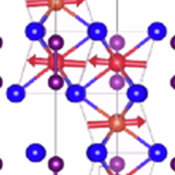
Magnetic van der Waals (vdW) materials exhibit a profound interconnectedness between their various degrees of freedom, pointing to a wealth of potential applications in low-power and high-speed spintronic devices. Recently, light-matter interactions have been leveraged as robust, dynamic pathways to gain control over the properties of vdW magnets through the use of ultrafast pulses of light.
In this work recently published in npj Spintronics, a CINT User Team including Luis Martinez, Prashant Padmanabhan, and Michael Pettes utilized ultrafast photoexcitation to drive coherent lattice oscillations in the layered ferrimagnetic crystal Mn3Si2Te6, which significantly stiffen below the magnetic ordering temperature. The team suggested that this is due to an exchange-mediated contraction of the lattice, stemming from strong magneto-structural coupling in this material. CINT highlight slide here.
Full article here: Dynamic Signatures of Spin-Lattice Coupling in the Layered Ferrimagnet Mn3Si2Te6
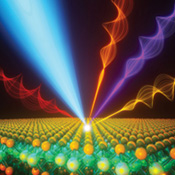
In addition to a plethora of emergent phenomena, the spatial topology of optical vortices enables an array of applications in optical communications and quantum information science. Multibeam nonlinear optical processes, augmented by optical vortices, are essential in this context, providing robust access to an infinitely large set of quantum states associated with the orbital angular momentum of light.
In this work recently published and featured on the cover of ACS Nano, a CINT User Team including Prashant Padmanabhan, Tenzin Norden, Luis Martinez, Nehan Tarefder, Luke McClintock, Jinkyoung Yoo, Jian-Xin Zhu, Antoinette Taylor, Rohit Prasankumar, and Wilton Kort-Kamp pushed the boundaries of vortex nonlinear optics to the ultimate limits of material dimensionality. By exploiting multipulse difference frequency, sum frequency, and four-wave mixing in monolayer quantum materials, the team demonstrates their ability to independently control the orbital angular momentum and radial distribution of vortex light-fields in addition to their wavelength. CINT highlight slide here.
Full article here: Twisted Nonlinear Optics in Monolayer van der Waals Crystals
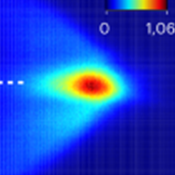
The additional layer degree of freedom in trilayer moiré superlattices of transition metal dichalcogenides enables the emergence of novel excitonic species, such as quadrupolar excitons, which exhibit unique excitonic interactions and hold promise for realizing intriguing excitonic phases and their quantum phase transitions. Concurrently, the presence of strong electronic correlations in moiré superlattices, as exemplified by the observations of Mott insulators and generalized Wigner crystals, offers a direct route to manipulate these new excitonic states and the resulting collective excitonic phases.
In this recent Nature Photonics article, a CINT User Team including Shi-Zeng Lin demonstrates that strong exciton–exciton and electron–exciton interactions, both stemming from robust electron correlations, can be harnessed to controllably drive transitions between quadrupolar and dipolar excitons. CINT highlight slide here.
Full article here: Strong-Interaction-Driven Quadrupolar-to-Dipolar Exciton Transitions in a Trilayer Moiré Superlattice

The original proposal of quantum key distribution (QKD) was based on ideal single-photon sources, which, 40 years later, are still challenging to develop. Therefore, the development of decoy-state protocols using weak coherent states (WCS) from lasers set the frontier in terms of secure-key rates and distances.
In this article published in PRX Quantum, a CINT User Team including Eric Bowes and Jennifer Hollingsworth proposed and experimentally demonstrated two simple-to-implement QKD protocols that allow practical far from ideal sub-Poissonian photon sources to outperform state-of-the-art WCS. CINT highlight slide here.
Full article here: Decoy-State and Purification Protocols for Superior Quantum Key Distribution with Imperfect Quantum-Dot-Based Single-Photon Sources: Theory and Experiment
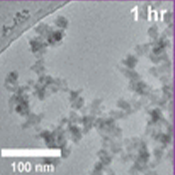
Enzymes are nature’s catalysts, but their instability outside native environments limits practical applications. Metal–organic frameworks (MOFs) offer a promising platform for enzyme immobilization, enhancing stability, and reusability through their tunable porosity and crystallinity.
In this Chemistry of Materials article, a CINT User Team including John Watt reports that NH4OH modulates crystal morphology, enzyme activity, and nucleation behavior, with higher concentrations leading to partial enzyme denaturation and reduced catalytic performance. By integrating time-resolved cryo-TEM with activity assays, we uncover how modulator concentration impacts early stage crystallization and enzyme folding, a mechanistic insight not previously demonstrated in MOF systems. CINT highlight slide here.
Full article here: Role of Ammonium Hydroxide on Glucose Oxidase Immobilized in Metal–Azolate Framework-7 Enzyme Activity
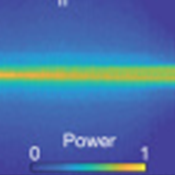
Silicon-based photonic integrated circuits (Si-PICs) have evolved over the past four decades, revolutionizing optical communication, sensing, artificial intelligence training, and quantum technologies. The successful integration of on-chip laser sources marked a major breakthrough in silicon photonics, yet further advancements are essential to unlock its full potential and expand its applications.
In this Optica article, a CINT User Team including Weng Chow reports high-Q locking configurations, an approach that leverages a broadband external cavity, effectively mitigating thermorefractive noise and mode-hopping while ensuring stable operation. CINT highlight slide here.
Full article here: Sub-Hertz-Linewidth Hybrid-Integrated Laser for Isolator-Free Silicon Photonics
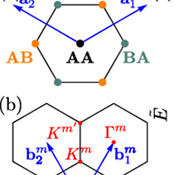
Landau levels have been central to the discovery of exotic quantum phases and their unprecedentedly deep roots in geometry and topology. A powerful concept called “vortexability” extends this framework to moiré systems.
In this Physical Review Letter, a CINT User Team including Shi-Zeng Lin shows that vortexable systems support not only Landau-level-like flat bands but also entirely new types with distinct topological properties. CINT highlight slide here.
Full article here: Symmetry-Based Classification of Exact Flat Bands in SIngle and Bilayer Moiré Systems
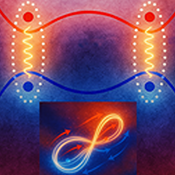
Excitonic insulators formed by the pairing of electrons and holes due to Coulomb interactions were first predicted more than 50 years ago. Since then, excitonic insulators have been observed in various classes of materials, including quantum Hall bilayers, graphite, transition metal chalcogenides, and more recently in moiré superlattices.
In this Physical Review Letters article, a CINT User Team with Michael Pettes reports the experimental observation of a spin-triplet excitonic insulator in the ultra-quantum limit of a three-dimensional topological material HfTe5, observing that the spin-polarized zeroth Landau bands dispersing along the field direction cross each other beyond a characteristic magnetic field in HfTe5, forming the one-dimensional Weyl mode. CINT highlight slide here.
Full article here: Possible Spin-Triplet Excitonic Insulator in the Ultraquantum Limit of HfTe 5
Strain engineering is vital for tuning the optical and spin properties of solid-state color centers, enhancing spin coherence and compensating emission wavelength shift.
In this article published in Nature Communications, a CINT User Team including Matt Eichenfield developed an all-optical approach to directly modify the local strain of color centers at the nanoscale by migrating the nearby defect CINT highlight slide here.
Full article here: All-Optical Reconfiguration of Single Silicon-Vacancy Centers in Diamond for Non-Volatile Memories

Quantum ghost imaging is a method that utilizes the correlated detection of two photons to generate an image. One photon is detected by an imaging sensor and the other by a single-element bucket detector. The selection of the imaging sensor and its capabilities relative to the bucket detector impact the quality of the ghost images.
In this work, a CINT User Team including Duncan Ryan examined a SPAD array and a photocathode detector as imaging sensors for quantum ghost imaging. The team discusses how to achieve optimal images using these two technologies and demonstrated that these devices are able to generate ghost images at 1Hz frame rates, expanding the technique to biologically relevant time scales. CINT highlight slide here.
Full article here: Time-Resolved Detectors for Quantum Ghost Imaging
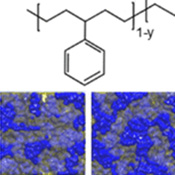
Using all-atom molecular dynamics simulations and a variety of experimental methods, it was previously reported on a linear polyethylene with pendant phenyl sulfonated groups precisely on every fifth carbon along the backbone. With increasing relative humidity this fluorine-free polymer self-assembled to form nanoscale water channels and exhibited exceptional proton conductivity.
In this work, a CINT User Team including Amalie Frischknecht quantitatively describe the nature of the water channels using the characteristic distance, channel width distribution, the area per sulfonate group at the hydrophilic / hydrophobic interface, and the fractal dimension. Notably, the channel widths and the areas per sulfonate group are nominally independent of the level of sulfonation, while depending significantly on the level of hydration. The fractal dimension of the water channels correlates strongly with the water diffusion coefficients calculated from the MD simulations. These findings demonstrate that the 5PhSH-Y hydrocarbon copolymers can be modified to tune properties particularly proton conductivity. CINT highlight slide here.
Full article here: Effect of Sulfonation Level on the Percolated Morphology and Proton Conductivity of Hydrated Fluorine-Free Copolymers: Experiments and Simulations
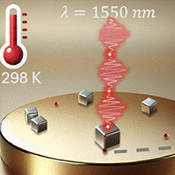
Single photons are cornerstones of quantum technologies. The need for an ultrafast, bright, and stable photon source emitting in the telecom-band at ∼1550 nm, ideally operating at room temperature, has resulted in a decades-long quest.
In this ACS Nano research, stable colloidal PbS/CdS quantum dots are embedded in a solution-synthesized nanoparticle-on-mirror cavity. Single cavity-coupled quantum dots experience extreme Purcell factors up to 10,700, resulting in ultrafast emission lifetimes of 65 ps, along with near-complete blinking suppression. As a result, 12 million single photons are emitted per second affording a single photon source at 1550 nm that is more than two orders of magnitude brighter than previously possible at room-temperature. CINT highlight slide here.
Full article here: Solution-Processed Ultrafast, Room-Temperature Single-Photon Source at 1550 nm
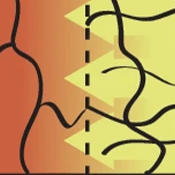
Material design and accessible manufacturing are often at odds with each other, calling for creative solutions to adapt high-performance materials to available processes.
In this research recently published in Nature Communications, a CINT User Team provides a solution to make thermoset materials amenable to vacuum forming. Specifically, an ambient polymerization is used to transition a liquid monomeric solution to an elastomeric gel. CINT highlight slide here.
Full article here: Frontal Polymerization of Thermosets to Enable Vacuum-Formed Structural Electronics
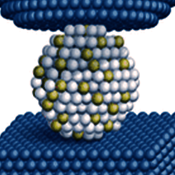
The adhesion of nanoparticles to their supports is key to their performance and stability. However, scientific advances in this area have been hampered by the difficulty of experimentally probing adhesion. To date, only a single technique has been developed that can directly measure nanoparticle adhesion, and this technique is inherently limited to monometallic systems.
In this , a CINT User Team presents a versatile technique for the direct measurement of adhesion for bimetallic nanoparticle systems. CINT highlight slide here.
Full article here: In Situ Measurement of Adhesion for Multimetallic Nanoparticles
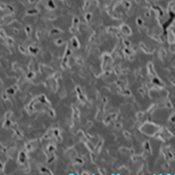
Realizing innovative composite materials with passive thermal management capabilities and minimal ecological footprints is a challenging but much sought-after goal that would have a transformative effect on renewable energy sciences.
In this , a CINT User Team demonstrates an environmentally friendly metasurface utilizing vanadium dioxide (VO 2) that offers responsiveness to ambient temperature and potentially long-term stability. CINT highlight slide here.
Full article here: Passive Radiative Thermal Management Using Phase-Change Metasurfaces
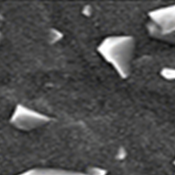
All-solid-state lithium–metal batteries hold great promise because of their high energy density stemming from using an energy-dense lithium–metal anode. However, mitigating the dendritic lithium–metal growth, originating from heterogeneous lithium–metal deposition, is a priority to suppress short-circuit and extend cycle life.
In this research recently published in ACS Nano, a CINT User Team employs direct current (DC) magnetron sputter coating to deposit tin (Sn) and carbon (C) on a stainless steel (SUS) current collector to achieve uniform lithium–metal plating and improve cycling performance. CINT highlight slide here.
Full article here: Tin–Carbon Dual Buffer Layer to Suppress Lithium Dendrite Growth in All-Solid-State Batteries.
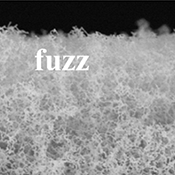
Developing high-performance plasma-facing materials (PFMs) is one of the most urgent and challenging tasks in the field of material for the realization of commercial fusion reactors because PFM suffers from harsh environments, including irradiation by high fluxes of hydrogen isotopes (D and T) and He plasma.
In this Acta Materialia article, a CINT User Team studies the radiation resistance of tungsten-containing amorphous refractory multi-component alloy film via He plasma irradiation. CINT highlight slide here.
Full article here: A New Type of Plasma Irradiation-Resistant Amorphous TiZrHfTaW refractory Multi-Component Alloy
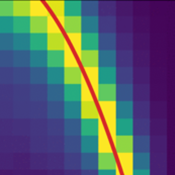
Quantum spin liquids (QSLs) are exotic phases of matter that avoid long-range ordering at zero temperature . Rather, these phases are characterized by topological order associated with fractionalization, emergent gauge fields, and Abelian or non-Abelian anyonic quasiparticles. Interest in QSLs was initially driven by proposals linking them to high-temperature superconductivity upon doping . Further understanding of QSLs showed that they have promising applications in topological quantum computation . Despite such great interest and potential applications, a definitive experimental observation of these phases is still lacking after decades of search.
In this Physical Review Letters article, a CINT User Team including CINT Scientist Shi-Zeng Lin studies quasiparticle interference (QPI) in the Kitaev quantum spin liquid (QSL) for electrons tunneling into the QSL. Local tunneling conductance around a spin vacancy or localized vison reveals unique features associated with fractionalized Majorana fermions, chargons, and visons. In certain parameter regimes, the single-spinon density of states and momentum dispersion can both be directly extracted from the tunneling conductance. Their results suggest that QPI is a promising tool for identifying the Kitaev QSL and its fractionalized excitations. CINT highlight slide here.
Full article here: Quasiparticle Interference in Kitaev Quantum Spin Liquids

The diode effect has been advanced by the introduction of topology into condensed matter physics, which imposes great potential for future optoelectronic devices. Such applications have been demonstrated in two-dimensional thin films or heterostructures but not yet in prototype three-dimensional topological insulators.
In this PNAS article, a CINT User Team demonstrates a topological diode effect on the surface of a three-dimensional material, SmB
Full article here: Realizing a Topological diode Effect on the Surface of a Topological Kondo Insulator
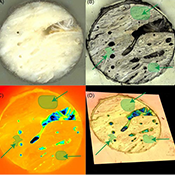
Quantifying the material properties of hard biological materials can improve understanding of the relationships between form, function, and performance. This study illustrates the use of nanoindentation as a tool for evaluating material properties in a comparative biology framework.
In this Integrative Organismal Biology article, a CINT User Team provides a step-by-step guide for comparative and evolutionary biologists illustrating the collection and analysis of nanoindentation data from samples of artiodactyl skull bones. CINT highlight slide here.
Full article here: A Brief Introductory Guide to Nanoindentation for Comparative and Evolutionary Biologists, with a Case Study of Bone Material Property Diversity across Artiodactyl Skulls
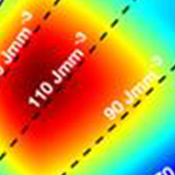
With the advent of additive manufacturing, manipulation of typical microstructural elements such as grain size, texture, and defect densities is now possible at a faster time scale. While the processing–structure–property relationship in additive manufactured metals has been well studied over the past decade, little work has been done in understanding how this process affects the dynamic behavior of materials.
In this Journal of Applied Physics article, a CINT User Team postulates that additive manufacturing can be used to alter materials' microstructure and used to enhance its dynamic strength. CINT highlight slide here.
Full article here: Tailoring Additive Manufacturing to Optimize Dynamic Properties in 316l Stainless Steel
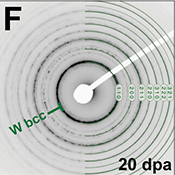
Since the 1970s, materials selection for application in future thermonuclear fusion reactors has posed a significant challenge for materials science and metallurgy. The deuterium-tritium fusion reaction exposes fusion reactors and their structural materials to exceptionally harsh environmental conditions.
In this Advanced Science article, a CINT User Team demonstrates that reducing alloying elements in RHEAs is feasible without compromising radiation tolerance. Herein, two Highly Concentrated Refractory Alloys (HCRAs) — W 53Ta 44V 3 and W 53Ta 42V 5 (at.%) — were synthesized and investigated. CINT highlight slide here.
Full article here: High Radiation Resistance in the Binary W-Ta System Through Small V Additions: A New Paradigm for Nuclear Fusion Materials
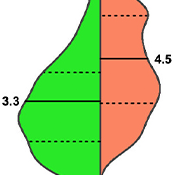
Catalysts based on Pt nanoparticles supported on carbon (Pt/C) are widely used in proton-exchange membrane fuel cell (PEMFC) cathodes. The Pt weight percent (wt%) and the type of carbon used influence the PEMFC performance and durability, but the mechanism of this influence remains poorly understood
In this Electrochimica Acta article, a CINT User Team systematically investigate the effect of catalyst metal content and the type of carbon support on PEMFC performance and durability by employing two types of commercially available Pt/C catalysts. CINT highlight slide here.
Full article here: Effect of the Catalyst Metal Content and the Carbon Support on Proton-Exchange Membrane Fuel Cells Performance and Durability

Low-current multilevel programmability with inherent non-volatility and high stability of resistance states is required for both multi-bit memory storage and deep learning accelerators but is difficult to achieve.
In this Advanced Functional Materials article, a CINT User Team realizes >512 (>9 bits) distinct non-volatile conductance levels with stable retention for each state with current levels down to the nanoampere range, highly promising for potential integration with small processing nodes with ultra-low power consumption requirements. CINT highlight slide here.
Full article here: Ultra-Fast Non-Volatile Resistive Switching Devices with Over 512 Distinct and Stable Levels for Memory and Neuromorphic Computing
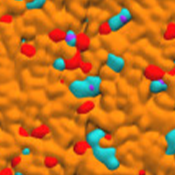
Alkaline water electrolysis holds promise in decarbonizing the global economy by enabling renewable hydrogen production with non-precious group metal catalysts. Anion exchange membranes are an important component of alkaline water electrolyzers and would ideally be durable while allowing for high hydroxide conductivity.
In this Journal of Membrane Science article, a CINT User Team performs atomistic molecular dynamics (MD) simulations of several PAP polymers at experimentally relevant hydration levels and polymer ion exchange capacities (IECs) to gain nanoscale insight into their properties and to help elucidate the trade-offs that result from tuning the IECs through the polymer stoichiometry.. CINT highlight slide here.
Full article here: Effect of Stoichiometry and Hydration Level on Water Domain Size and Transport in Poly(aryl piperidinium) Alkaline Anion-exchange Membranes
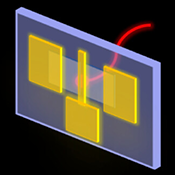
GeSn is a group-IV alloy with immense potential to advance microelectronics technology due to its intrinsic compatibility with existing Si CMOS processes.
In this ACS Applied Materials & Interfaces article, a CINT User Team presents a polycrystalline thin-film GeSn phototransistor on a fused silica substrate with a Sn composition of ∼10%, showing a photoresponse in the short-wave infrared wavelength range, critical for emerging sensing applications. CINT highlight slide here.
Full article here: Gate-Tunable Short-Wave Infrared Polycrystalline GeSn Phototransistors on Noncrystalline Substrates
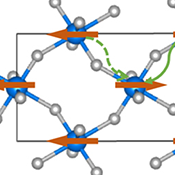
The coexistence of electric and magnetic order in multiferroics has made these materials the subject of intense investigation, due to the possibility of indirectly manipulating charge, spin, and orbital degrees of freedom by exploiting the strong coupling between these various quantities.
In this Nanophotonics article, a CINT User Team presents an optical pump-terahertz (THz) probe study on multiferroic Eu 0.75Y 0.25MnO 3. CINT highlight slide here.
Full article here: Electrodynamics of Photo-Carriers in Multiferroic Eu0.75Y0.25MnO3

High-quality materials are a key enabler pushing the boundaries of basic science and engineering, as manifested in the modern backbone of semiconductors-based transistors and low-dimensional carrier gas channels.
In this Small Methods perspective, a CINT User Team with CINT Scientist Jinkyoung Yoo discusses the status of epitaxially grown materials, the challenges in epitaxy research, and integration of modeling epitaxy and ultimate control of the epitaxy process with advanced characterization techniques. CINT highlight slide here.
Full article here: Epitaxy of Emerging Materials and Advanced Heterostructures for Microelectronics and Quantum Sciences
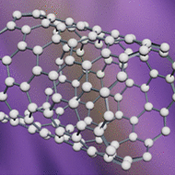
Single-wall carbon nanotubes (SWCNTs) are a widely studied family of artificial nanomaterials that are well-known for their varied, structure-specific optical and electronic properties. To tailor and expand the range of these properties, researchers increasingly rely on chemical reactions that modify SWCNT electronic structures.
In this ACS Nano article, a CINT User Team with CINT Scientist Han Htoon investigates how this reaction system is affected by pH level, dissolved O 2 content, and radical scavengers and traps. Products were characterized with near-IR fluorescence, Raman, and XPS spectroscopy. The reaction is greatly accelerated by removal of dissolved O 2 and strongly suppressed by TEMPO, a radical trap. CINT highlight slide here.
Full article here: Complexity in the Photofunctionalization of Single-Wall Carbon Nanotubes with Hypochlorite
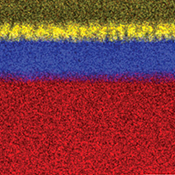
Epitaxial thin film transfer has enormous potential for thin film devices free from the traditional substrate epitaxy limitations. However, large-area continuous film transfer remains a challenge for the commonly reported polymer-based transfer methods due to bending and cracking during transfer, especially for highly strained epitaxial thin films.
In this Advanced Electronic Materials article, a CINT User Team including CINT Scientists Raktim Sarma, Igal Brener, and Chloe Doiron employs a new epoxy-based, rigid transfer method to transfer films from an SrTiO 3 (STO) growth substrate onto various new substrates, including those that will typically pose significant problems for epitaxy. CINT highlight slide here.
Full article here: Transfer of Millimeter-Scale Strained Multiferroic Epitaxial Thin Films on Rigid Substrates via an Epoxy Method Producing Magnetic Property Enhancement
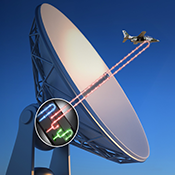
Quantum sensing promises to revolutionize sensing applications by employing quantum states of light or matter as sensing probes. Photons are the clear choice as quantum probes for remote sensing because they can travel to and interact with a distant target.
In this Physical Review X article, a CINT User Team including CINT Scientists Diego Dalvit, Abul Azad, and Hou-Tong Chen propose a novel quantum sensing framework that addresses these challenges using quantum frequency combs with path identity for remote sensing of signatures (“qCOMBPASS”). The combination of one key quantum phenomenon and two quantum resources — namely, quantum-induced coherence by path identity, quantum frequency combs, and two-mode squeezed light — allows for quantum remote sensing without requiring quantum memory. CINT highlight slide here.
Full article here: Quantum Frequency Combs with Path Identity for Quantum Remote Sensing

The field of data-driven chemistry is undergoing an evolution, driven by innovations in machine learning models for predicting molecular properties and behavior. Recent strides in ML-based interatomic potentials have paved the way for accurate modeling of diverse chemical and structural properties at the atomic level.
In this Chemical Reviews article, a CINT User Team including CINT Scientist Sergei Tretiak navigates the intricate landscape of essential components and integrity of training data that ensure the extensibility and transferability of the resulting models. CINT highlight slide here.
Full article here: Data Generation for Machine Learning Interatomic Potentials and Beyond

Emerging applications of metasurfaces in classical and quantum optics are driving the need for precise polarization control of nearly-degenerate, high quality (𝑄)-factor modes. However, current approaches to creating specifically polarized pairs of modes force a trade-off between maintaining high 𝑄 factors and robustness.
In this Physical Review Letters article, a CINT User Team including CINT Scientists Chloe Doiron, Igal Brener, and Alex Cerjan solve this challenge by employing pairwise generation, annihilation, and positioning of polarization singularities, derived from symmetry-guaranteed pairs of symmetry-protected bound states in the continuum. CINT highlight slide here.
Full article here: Dual-Band Polarization Control with Pairwise Positioning of Polarization Singularities in Metasurfaces
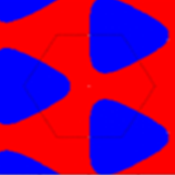
Magnetic skyrmion crystal (SkX) configurations were first theoretically proposed and then experimentally observed in chiral magnets. SkX formations have also been found in centrosymmetric magnets stabilized by competing exchange or dipolar interactions . Because of their topological nature and potential applications in spintronics , magnetic skyrmions have been a central focus in condensed matter physics over the past decade.
In this Physical Review Letters article, a CINT User team explores the emergence of SkXs within non-Kramers doublet systems. In these systems, all constituents of the skyrmions are multipolar moments devoid of any dipolar character. The distinct symmetry properties of these underlying multipolar moments suggest that non-Kramers skyrmions may harbor novel physics that is not shared by their dipolar counterparts. CINT highlight slide here.
Full article here: Multipolar Skyrmion Crystals in Non-Kramers Doublet Systems

Photonic computing has the potential to harness the full degrees of freedom (DOFs) of the light field, including the wavelength, spatial mode, spatial location, phase quadrature, and polarization, to achieve a higher level of computing parallelism and scalability than digital electronic processors. While multiplexing using the wavelength and other DOFs can be readily integrated on silicon photonics platforms with compact footprints, conventional mode-division multiplexed (MDM) photonic designs occupy areas exceeding tens to hundreds of microns for a few spatial modes, significantly limiting their scalability.
In this Optica article, a CINT User Team utilizes inverse design to demonstrate an ultracompact photonic computing core that calculates vector dot products based on MDM coherent mixing. CINT highlight slide here.
Full article here: Mode-Multiplexed Photonic Integrated Vector Dot-Product Core from Inverse Design
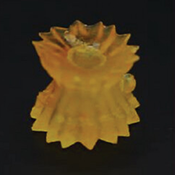
Digital light process (DLP) 3D printing is an increasingly widespread vat polymerization method for producing complex 3D structures using additive manufacturing.
In this Advanced Materials article, a CINT User team documents the preparation of aligned, main-chain LCEs via DLP 3D printing using a 100 mT magnetic field. CINT highlight slide here.
Full article here: Digital Light Process 3D Printing of Magnetically Aligned Liquid Crystalline Elastomer Free–forms
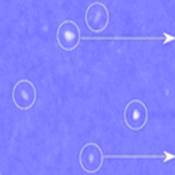
Excitons – quasi-particle bound states of electron–hole pairs – are investigated extensively as they serve as the foundation of almost all modern photonic technologies. The efforts of the past decades focused on uncorrelated excitons in conventional semiconductors where quasi-particles weakly interact with one another. Currently, correlated excitons are generating significant interest due to their intrinsic many-body interactions entangling charge, spin, orbital, and lattice degrees of freedoms.
In this Nanoscale Horizons article, a CINT User team shows that by reducing the lateral dimension of correlated antiferromagnet NiPS 3 flakes to tens of nanometers and thickness to less than ten nanometers, we can switch-off the bulk spin–orbit entangled exciton in the near-infrared (1.47 eV) and activate visible-range (1.8–2.2 eV) transitions. CINT highlight slide here.
Full article here: Correlated Excitons in a Nanoscale 2D-Antiferromagnet

Atomic defects in crystals are a promising platform for constructing quantum networks, in which individual defects are connected over long distances using light. Such networks could lead to a new generation of quantum sensors, quantum computers, and quantum communication techniques.
In this accepted Physical Review X article, a CINT User team shows this high-fidelity readout is compatible with other advantages of this qubit, and is ready for application in quantum technologies. CINT highlight slide here.
Full article here: Single-Shot Readout and Weak Measurement of a Tin-Vacancy Qubit in Diamond
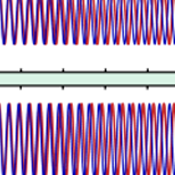
Exceptional points (EPs) — singularities in the parameter space of non-Hermitian systems where two nearby eigenmodes coalesce — feature unique properties with applications such as sensitivity enhancement and chiral emission. Existing realizations of EP lasers operate with static populations in the gain medium.
In this Nature article, a CINT User team including CINT Scientist Alex Cerjan analyzes full-wave Maxwell–Bloch equations to show that in a laser operating sufficiently close to an EP, the nonlinear gain will spontaneously induce a multi-spectral multi-modal instability above a pump threshold, which will initiate an oscillating population inversion and generate a frequency comb. CINT highlight slide here.
Full article here: Dynamic Gain and Frequency Comb Formation in Exceptional-Point Lasers.
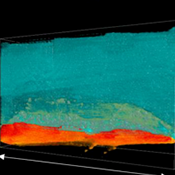
Sodium ion batteries (SIBs) and sodium metal batteries (SMBs) are promising options in next- generation energy storage technology. However, before sodium metal can be rightfully considered as a viable anode it has to overcome the critical challenge of interfacial instability during electrodeposition/dissolution. For anode-free SMBs (AF-SMBs), where the cathode is the only ion reservoir, the challenge is to achieve stable electrodeposition/dissolution onto an "empty" current collector, rather than onto pre-existing sodium metal.
In this Angewandte Chemie article, a CINT User team including CINT Scientist John Watt employs a model system based on a lithiophilic composite of Na 2Te intermetallics and Cu microparticles. The key rationale for using this composite support is that it "does not move", i.e. there are no volume changes during electrodeposition/dissolution of Na. Both Na 2Te and Cu are thermodynamically stable at anode-relevant voltages. During cycling such supports do not react with Na, and yet remain highly sodiophilic due to the nature of the electronic structure of the alkaline-ion containing intermetallic. CINT highlight slide here.
Full article here: Interdependence of Support Wettability - Electrodeposition Rate- Sodium Metal Anode and SEI Microstructure
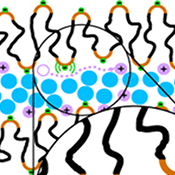
Safe, efficient, and reliable batteries are critical to the future of an electricity-based society. A critical component of commercially relevant batteries is the electrolyte, and new electrolyte materials are necessary for next-generation batteries. Synthetic polymers have been suggested as one possibility, as they have excellent mechanical and chemical stability and some can dissolve lithium salts.
In this Chemistry of Materials article, a CINT User team including CINT Scientists Amalie Frischknecht and Mark Stevens demonstrate that a multiblock lithium-ion-conducting polymer can be swollen with ethylene carbonate solvent to increase the conductivity relative to the dry polymer material by nearly 4 orders of magnitude. CINT highlight slide here.
Full article here: Partial Solvation of Lithium Ions Enhances Conductivity in a Nanophase-Separated Polymer Electrolyte
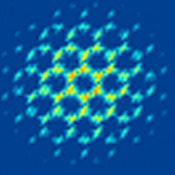
Extensive efforts have been dedicated to improving optoelectronic and light harvesting functions of dendrimers through the optimization of their topologies, structural rigidity, and electronic-vibrational (vibronic) couplings. For instance, initial investigations revealed the pivotal role of building block connectivity and topology in dendritic structures.
In this Journal of the American Chemical Society article, a CINT User team working with CINT Scientist Sergei Tretiak shows how charge migration in a dendrimer can be manipulated by placing it in an optical cavity and monitored by time-resolved X-ray diffraction. Their simulations demonstrate that the dendrimer charge migration modes and the character of photoexcited wave function can be significantly influenced by the strong light-matter interaction in the cavity. This presents a new avenue for modulating initial ultrafast charge dynamics and subsequently controlling coherent energy transfer in dendritic nanostructures. CINT highlight slide here.
Full article here: Cavity Manipulation of Attosecond Charge Migration in Conjugated Dendrimers
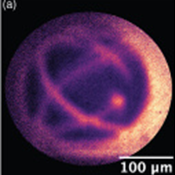
Quantum ghost imaging (QGI) is a method that measures absorption at extremely low light intensities. Nondegenerate QGI probes a sample at one wavelength while forming an image with correlated photons at a different wavelength. This spectral separation alleviates the need for imaging detectors with high sensitivity in the near-infrared (NIR) region, thereby reducing the required illumination intensity.
In this Optica article, a CINT User team uses NCam, a single-photon detector to demonstrate nondegenerate QGI with unprecedented sensitivity and contrast, obtaining images of living plants with less than 1% light transmission.shows that analog photonic encoders could address this challenge, enabling high-speed image compression using orders-of-magnitude lower power than digital electronics. CINT highlight slide here.
Full article here: Infrared Quantum Ghost Imaging of Living and Undisturbed Plants
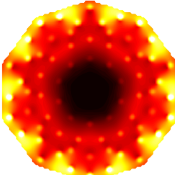
In the recent years, photonic Chern materials have attracted substantial interest as they feature topological edge states that are robust against disorder, promising to realize defect-agnostic integrated photonic crystal slab devices. However, the out-of-plane radiative losses in those photonic Chern slabs has been previously neglected, yielding limited accuracy for predictions of these systems’ topological protection.
In this Nanophotonics article, a CINT User Team including CINT Scientist Alexander Cerjan develops a general framework for measuring the topological protection in photonic systems, such as in photonic crystal slabs, while accounting for in-plane and out-of-plane radiative losses. CINT highlight slide here.
Full article here: Classifying Topology in Photonic Crystal Slabs with Radiative Environments.
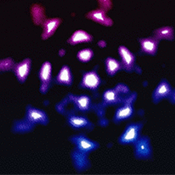
Current reports of thermal expansion coefficients (TEC) of two-dimensional (2D) materials show large discrepancies that span orders of magnitude. Determining the TEC of any 2D material remains difficult due to approaches involving indirect measurement of samples that are atomically thin and optically transparent.
In this ACS Nano article, a CINT User team presents a substrate-free experimental characterization technique to directly measure the localized thermal expansion coefficient of the polycrystalline 2D TMD material WSe 2, using 4-dimensional scanning transmission electron microscopy (4D-STEM) paired with complex computational data analysis.
CINT highlight slide here.
Full article here: Direct Measurement of the Thermal Expansion Coefficient of Epitaxial Wse2 by Four-Dimensional Scanning Transmission Electron Microscopy
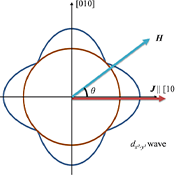
Thermal conductivity is a powerful transport probe of a superconducting state. The superconducting condensate does not carry heat current; only normal quasiparticles participate in electronic (charge) thermal transport. As a result, thermal conductivity is exquisitely sensitive to the structure of the superconducting energy gap
In this Physical Review Letters article, a CINT User Team demonstrates that the thermal-conductivity measurement in rotating magnetic field can probe the normal parts of the Fermi surface deep inside the superconducting state.
CINT highlight slide here.
Full article here: Normal Fermi Surface in the Nodal Superconductor CeCoIn5 Revealed via Thermal Conductivity
Aluminum oxide (Al2O3) is known to stabilize the SEI of lithium and sodium metal batteries. However, it is not feasible to employ standard physical vapor deposition (PVD) and chemical vapor deposition routes (CVD) routes to coat it onto low melting-point K anodes.
In this Angewandte Chemie article, a CINT User Team including CINT Scientist John Watt addresses this challenge by room-temperature spin coating 10 μm films of Al2O3 nanopowder onto both sides of a commercial polypropylene separator.
CINT highlight slide here.
Full article here: Alumina – Stabilized SEI and CEI in Potassium Metal Batteries

Modern lens designs are capable of resolving greater than 10 gigapixels, while advances in camera frame-rate and hyperspectral imaging have made data acquisition rates of Terapixel/second a real possibility. The main bottlenecks preventing such high data-rate systems are power consumption and data storage.
In this Nature Communications article, a CINT User team shows that analog photonic encoders could address this challenge, enabling high-speed image compression using orders-of-magnitude lower power than digital electronics. Our approach relies on a silicon-photonics front-end to compress raw image data, foregoing energy-intensive image conditioning and reducing data storage requirements. The compression scheme uses a passive disordered photonic structure to perform kernel-type random projections of the raw image data with minimal power consumption and low latency. A back-end neural network can then reconstruct the original images with structural similarity exceeding 90%. This scheme has the potential to process data streams exceeding Terapixel/second using less than 100 fJ/pixel, providing a path to ultra-high-resolution data and image acquisition systems.
CINT highlight slide here.
Full article here: Integrated Photonic Encoders for Ultrafast and Low Power Image Processing
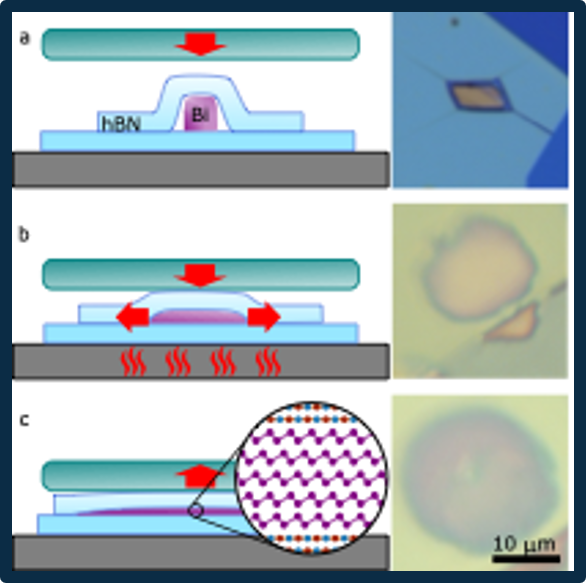
Confining materials to two-dimensional forms changes the behaviour of the electrons and enables the creation of new devices. However, most materials are challenging to produce as uniform, thin crystals.
In this research published in Nature Materials, a CINT User Team working with CINT Scientist Michael Pettes demonstrates that the atomically smooth nature of van der Waals materials such as hexagonal boron nitride make them ideal nanoscale molds for confined crystal growth, shown here to obtain 2D bismuth. CINT highlight slide here.
Full article here: Exceptional Electronic Transport and Quantum Oscillations in Thin Bismuth Crystals Grown inside van der Waals Materials
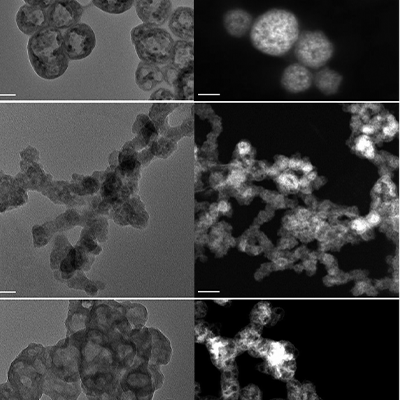
Numerous physical (top-down) and chemical (bottom-up) approaches to NP synthesis have been applied for the synthesis of ZnO and other NPs. The former, however, tends to be energy intensive, while the latter often requires the use of toxic reducing agents, and/or non-aqueous organic solutions, impacting their biomedical potential. Both of these conventional approaches also require extreme conditions with regard to temperature, pressure, or pH, presenting barriers in the areas of energy consumption, cost, and environmental toxicity.
In this Nanoscale article, a CINT User Team that included CINT Scientists John Watt and George Bachand, as well as CINT Technical Specialist Winson Kuo suggests that small molecule metabolites present in fungal exudates play a key role in the mycosynthesis of well-defined NPs, while the composition and concentration of proteins is less important. Learn more about this research. CINT highlight slide here.
Full article here: Identifying Biochemical Constituents Involved in the Mycosynthesis of Zinc Oxide Nanoparticles
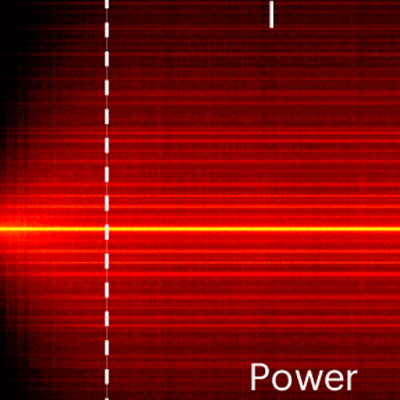
Ultralow-noise laser sources are crucial for a variety of applications, including microwave synthesizers, optical gyroscopes and the manipulation of quantum systems. Silicon photonics has emerged as a promising solution for high-coherence applications due to its ability to reduce the system size, weight, power consumption, and cost.
In this research published in Nature Photonics, a CINT User Team working with CINT Affiliate Scientist Weng Chow demonstrates quantum-dot lasers grown directly on Si that achieve self-injection-locking laser coherence under turnkey external-cavity locking. CINT highlight slide here.
Full article here: Turnkey Locking of Quantum-dot Lasers directly Grown on Si
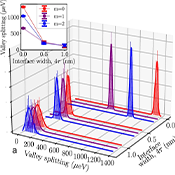
Si/Ge heteroepitaxial growth yields pristine host material for quantum dot qubits, but residual interface disorder can lead to qubit-to-qubit variability that might pose an obstacle to reliable Si/Ge-based quantum computing.
In this research published in npj Quantum Information, a CINT User Team working with CINT Scientist Andrew Mounce and CINT Affiliate Scientist Ezra Bussmann reconstruct 3D interfacial atomic structure and employ an atomistic multi-valley effective mass theory to quantify qubit spectral variability. CINT highlight slide here.
Full article here: Modeling Si/SiGe Quantum Dot Variability Induced by Interface Disorder Reconstructed from Multiperspective Microscopy

Materials that can toggle between two states with distinct properties are important for information storage technology. Phase-change materials, for example, have been widely used for rewriteable optical data storage. They are valued not only for their versatile tunability but also for the low dimensionality that allows exotic properties to arise due to quantum confinement.
In this Nature Communications article, a CINT User team including CINT Scientist Jian-Xin Zhu demonstrates the non-volatile reversible switching of two closely related crystal structural phases in the vdW ferromagnet Fe 5GeTe 2 via an annealing and quenching procedure. CINT highlight slide here.
Full article here: Reversible Non-volatile Electronic Switching in a near-Room-Temperature van der Waals Ferromagnet

The strongly sample-dependent anomalous transport properties observed in the layered Dirac materials ZrTe5 and HfTe5 are known to strongly correlate with the presence of Te vacancies. One phenomenon, a negative longitudinal magnetoresistance (NLMR), is widely speculated to be a signature of broken chiral symmetry. However, the role of electronic structure in the sample dependence of the transport properties of these materials is poorly understood. This prompts the question as to whether the NLMR is a genuine signature of the chiral anomaly in ZrTe5 and HfTe5.
In this work published in Advanced Physics Research, the effect of Te vacancies on the electronic structure of ZrTe5 and HfTe5 is investigated via first-principles calculations. CINT highlight slide here.
Full article here: Te Vacancy-Driven Anomalous Transport in ZrTe5 and HfTe5
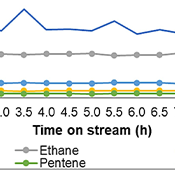
Development of shale gas and tight oil reserves could lead to a projected increase in the natural gas production of 100 % by the year 2050. Methane accounts for 70–90 mol.% of the shale gas feed composition depending on the location of the shale gas source . Despite the large availability of this carbon resource, current methane conversion methodologies are limited.
In this Chemical Engineering Journal article, non-oxidative coupling of methane provides as a means for carbon efficient conversion of methane to higher hydrocarbons. CINT highlight slide here.
Full article here: Catalytic Reactivity of Pt Sites for Non-oxidative Coupling of Methane (NOCM)
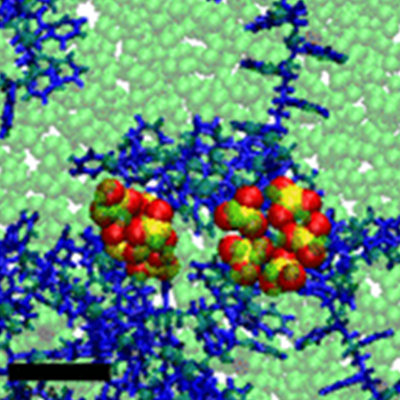
With results from real and reciprocal space, this study strives to correlate the effects of clustering on the translation of constraint dynamics from the atomistic level and segmental length scales to the overall motion of the polymers, using suflonated polystyrene in the ionomer regime
In this ACS Polymers article, results show that in melts, dynamics of the polymer depends on the counterion and cluster morphology. CINT highlight slide here.
Full article here: From Molecular Constraints to Macroscopic Dynamics in Associative Networks Formed by Ionizable Polymers
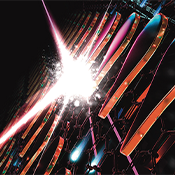
Traditional microelectronic architectures, with transistors to control electrical currents along wires, power everything from advanced computers to everyday devices. But with the integrated circuits offering diminishing returns in terms of speed and adaptability, Los Alamos National Laboratory scientists are developing nanometer-scale light-based systems that could deliver breakthroughs for ultrafast microelectronics, room-temperature infrared detection (for example, night vision) and a wide variety of technological applications.
As described in an article just published in Nature, the research team designed and fabricated asymmetric, nano-sized gold structures on an atomically thin layer of graphene. The gold structures are dubbed “nanoantennas” based on the way they capture and focus light waves, forming optical “hot spots” that excite the electrons within the graphene. Only the graphene electrons very near the hot spots are excited, with the rest of the graphene remaining much less excited. CINT highlight slide here.
Full article here: Light-driven Nanoscale Vectorial Currents

The fine-tuning of topologically protected states in quantum materials holds great promise for novel electronic devices. However, there are limited methods that allow for the controlled and efficient modulation of the crystal lattice while simultaneously monitoring the changes in the electronic structure within a single sample.
Here, we apply significant and controllable strain to high-quality HfTe 5 samples and perform electrical transport measurements to reveal the topological phase transition from a weak topological insulator phase to a strong topological insulator phase. CINT highlight slide here.
Full article here: Controllable Strain-Driven Topological Phase Transition and Dominant Surface-State Transport in HFTE5
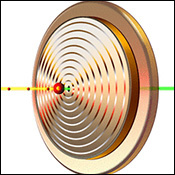
Solid-state-based single-photon sources (SPS) are the key for a host of quantum technologies. They serve as essential building blocks for quantum metrology, quantum networks, and quantum information processing.
A CINT User Team including Eric Bowes, Han Htoon, and Jennifer Hollingsworth demonstrated an important step toward on-chip integration of single-photon sources at room temperature. Excellent photon directionality is achieved with a hybrid metal–dielectric bullseye antenna, while back-excitation is permitted by placement of the emitter in a subwavelength hole positioned at its center. CINT highlight slide here.
Full article here: Room-Temperature Fiber-Coupled Single-Photon Sources based on Colloidal Quantum Dots and SiV Centers in Back-Excited Nanoantennas